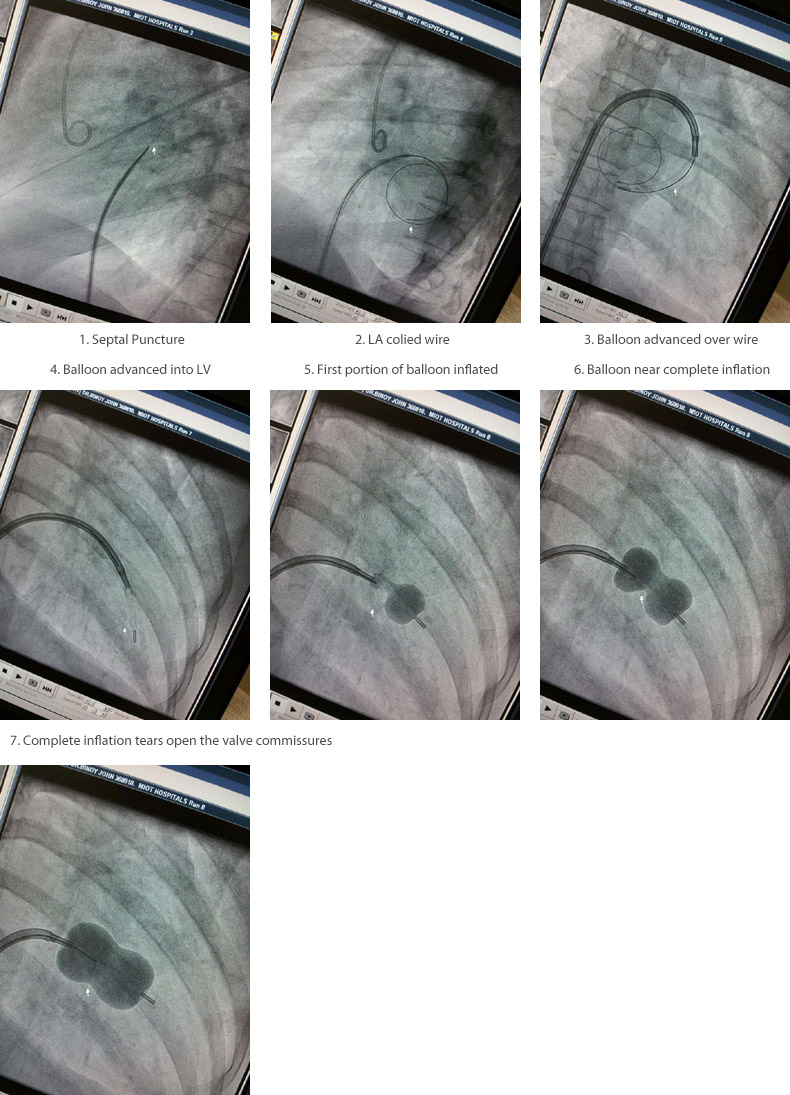Treatments & Procedures
Percutaneous Trans Mitral Commissurotomies (PTMC)
What is Percutaneous Trans-Mitral Commissurotomy or PTMC or Balloon Mitral Valvotomy or BMV?
Both are the same. Percutaneous Trans-Mitral Commissurotomy, is a procedure done for a cardiac pathology called MITRAL STENOSIS. Mitral stenosis is a pathology of one of the valves in the heart called the Mitral valve, where-by it undergoes progressive thickening resulting from child hood throat infection by a bacteria called Beta Hemolytic Streptococci. This thickening of the valve results in progressive obstruction to blood flow across the valve thereby causing back pressure to build inside the chambers behind the valve thereby resulting in breathing difficulty, abnormal heart beats and even clot formation leading to stroke or paralysis.
The treatment for this condition may be open heart surgery and replacement of the valve with a metal valve or tissue valve or without open heart surgery by means of a balloon passed into the heart and across the valve via the leg usually, by means of a small tube inserted under mere local anaesthesia, with the patient being discharged usually with-in 2 days following the procedure called Percutaneous Trans-Mitral Commissurotomy or PTMC. However, the general principle is to delay surgical valve replacement as much as possible as surgical replacement necessitates the patient to take life-long blood thinners or oral anti-coagulants which puts the patient at risk of bleeding and complicating any other surgical procedures he may need in his life time and the risk of life threatening bleeding in case of any trauma or accidents. Also there is the risk of the valve getting blocked suddenly if the medications are not taken on time or missed.
Procedure and Technique
The Mitral Valve is on the Left side of the heart and so to reach the left side of the heart, the heart is approached with a needle from the right side of the heart and a puncture (pin hole) is made on the wall between the right (Right atrium or RA) and left chamber (Left atrium or LA) of the heart called the “inter-atrial septum”.
- Thereafter a wire is passed into the left chamber via this pin hole
- and then after the hole is enlarged, a balloon is passed over this wire into the LA.
- Thereafter, the balloon is passed across the mitral valve into the chamber beyond the LA called the left ventricle or LV.
- Then the balloon which is a double balloon and consists of two portions is inflated serially such that first the further portion or distal portion is inflated while being kept right across the mitral valve
- and then the nearer portion or proximal portion is inflated while the waist starts tearing the commissures of the mitral valve.
- With complete inflation, the waist of the balloon tears the obstructed valve to a pre-planned diameter as required for each patient to achieve a good opening or result.

This procedure usually gives an excellent result which allows the patient to be free of symptoms and complications for an average of 5 to 10years and thus be free from the problems and complications that can arise from a surgical placement of a metal valve. However a PTMC may not be possible in all cases of Mitral stenosis and such cases can be treated only by open heart surgery and surgical valve replacement.
Also, it is important to note that PTMC is not free of risks and complications either and has a small percentage risk of death, bleeding from the heart and sudden leakage from the valve which may require emergency surgery. But generally, in the hands of a skilled and experienced interventional cardiologist such risks are lower.
MIOT HEART REVIVE CENTER, is a center with interventional cardiologists highly experienced in PTMCs even in pregnant women and very high risk cases of mitral stenosis.




